
The €120 million new terminal has been designed to handle 2.7 million passengers per year, or 1,800 passengers per hour. It is significantly larger than the old facilities, which had a capacity of one million passengers and limited capability to cope during peak periods. It is believed that the new terminal will herald “a new era for the airports of Cyprus”.
“The old terminal facilities were undersized and not functional. Despite an important refurbishment programme of works undertaken in 2006 immediately after Hermes Airports Limited took over the airport, the two separate arrival and departure buildings were unable to handle the highly concentrated traffic during the peak season with the minimum quality standard of service,” said Baric.
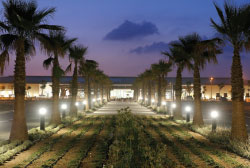
The new Pafos International Airport opened on 8 November. Traditional materials such as natural sandstone have been used in a contemporary way to clad the building. The interior design responds to the influences of the buildings and materials found on the island.
Pafos handled 1,744,011 passengers in 2007, with a forecast 0.4% growth to 1,751,000 passengers in 2008. Given the current global economic situation, Baric expects traffic in 2009 to remain at the 2008 level.
The new terminal is, so far, running smoothly, with all systems performing as they should. Baric explained that the smiles on the faces of passengers and airport staff convey the extent of the change in the travelling experience through Pafos International Airport. This is the result of several months of operational readiness and transfer preparation work with all airport stakeholders.
“By developing a specific ‘Sense of Place’ programme as part the design of the new terminal, we have given a real taste of Cyprus to this facility: The airport is simple, readable and attractive,” said Baric. “The 28 check-in counters and the four passenger security screening lanes have been designed to process the passengers in a swift manner to the wide boarding area fitted with a diversified and high quality offer of food and beverage and retail outlets.”
25-year concession agreement
The design was developed by Pascall+Watson architects working with Stantec. The terminal was designed and built by Bouygues Bâtiment International Cyprus Branch. The project is part of a 25-year Build-Operate-Transfer (BOT) contract in which French firm Bouygues Bâtiment International is the Design and Build contractor.
In 2005, the concession company Hermes Airports Limited and the Cypriot government signed the 25-year concession agreement for the design, construction and financing of new terminal buildings at Pafos and Larnaka, and the operation of both airports. Egis Projects, a subsidiary of Groupe Egis, is one of the main shareholders of the concession company. With a 20% shareholding it is the second largest investor. CEO Rik Joosten explained that it has played a leading role in negotiating the project with the Cypriot government and in implementing and operating it. Investors alongside Egis Projects include Bouygues Bâtiment International, Vancouver Airport Services (YVRAS), Aer Rianta, Nice Airport and Cypriot partners, CTC, Iacovou, Chapo and Hellenic Mining. “Together with YVRAS, we have developed a company that provides a number of senior staff in the airport,” said Joosten.
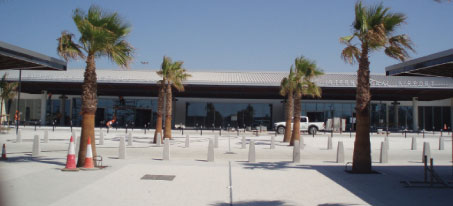
The new facility is considered particularly convenient for the operation of low-cost carriers, which currently have a very limited presence in Cyprus.
That company is called CAOG Airport Operations (Cyprus) Limited, in which YVRAS is the lead participant. Through CAOG, both YVRAS and Egis Projects have several seconded positions working for Hermes Airports. Mark Southern, managing director, CAOG Airport Operations (Cyprus) Limited, said: “This group of airport experts have a mandate to support the start up of both new terminals, provide day-to-day leadership and most importantly work and develop a talented group of Cypriot management to ultimately run the new world class airports.”
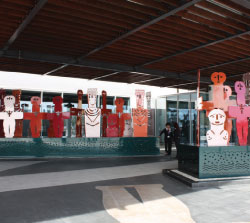
“By developing a specific ‘Sense of Place’ programme as part the design of the new terminal, we have given a real taste of Cyprus to this facility: The airport is simple, readable and attractive,” said general manager Olivier Baric.
Acting as the Owners Representative and leading the operational readiness efforts put CAOG in a leading role for the successful opening of Pafos. Specifically, YVRAS has shared its experience and knowledge in the development and planning of the new terminal building.
“This support delivers traditional operational and commercial expertise and, through work with local representatives, creates a ‘Sense of Place’ which reflects the people and culture of Cyprus. YVRAS has deployed this concept around the world and has been widely successful in connecting communities with their airport,” said Southern.
In partnership with Bouygues Bâtiment International, Egis Projects is supplying all aeronautical equipment for the Pafos and Larnaka terminals under a turnkey contract worth €60 million. This includes baggage handling systems, boarding bridges, passenger information systems (FIDS), check-in counters and all security equipment.
“It is a very challenging project, which has gone very well. The terminal is performing as expected and is of a very high quality,” said Joosten. “We will take lessons from the success of this project to the Larnaka project, where everything is on course for completion by 2009.”
Traditional materials used in contemporary way
Pascall+Watson architects, in conjunction with Stantec, calculated all the space requirements based on the Busy Hour rates and planned the building to reflect the space requirements for each function. “Provision was also made for other revenue generating activities such as retail and F+B. The building has been designed to provide sufficient space for all the facilities required and these will be provided to match passenger growth,” said Ian Douglas, Director, Pascall+Watson architects.
The original concept was based on a Roman villa. There was to be a central open space in the form of a landscaped garden with all the processing and revenue generating functions planned around it. In order to improve passenger flow and minimise the footprint of the terminal building the external landscaped garden was redesigned to become an internal atrium, which could accommodate commercial activity. “The architectural and interior design of the terminal responds to the demands of a 21st century international airport yet responds to the local context, culture and history of the site adjacent to the water to the west of the island of Cyprus,” said Douglas.
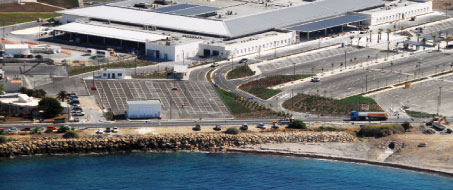
The 7120 million new terminal has been designed to handle 2.7 million passengers per year. It is a significant expansion on the old facility, which has a capacity of one million passengers and limited capability to cope during peak periods. Throughput this year is forecast to grow 0.4% to 1,751,000 passengers.
Traditional materials such as natural sandstone have been used in a contemporary way to clad the building. The interior design responds to the influences of the buildings and materials found on the island by re-interpreting them and using them in relevant way. “For example, traditional krokalia (small pebbles) have been used at the base of the concrete columns to provide a textural and contrasting colour change; mosaic tiles have been used to identify the entrances to toilets. This response to ‘Sense of Place’ has been enhanced by commissioning local artists to design installations appropriate to the island’s culture and mythology,” said Douglas.
Pascall+Watson architects and Stantec, working as part of the project team, were responsible for testing the initial project design to maximise the operational performance, consider life-cycle impacts and enable a cost-effective phasing programme. “In conjunction with Stantec we reviewed the initial design. It was value engineered by accurately calculating the space requirements to match the functions of the processes required in order to provide a viable economic solution. A modified design for the terminal was prepared and it was this that helped our client to negotiate an acceptable financial deal with the Cypriot government for a 25-year BOT contract,” said Douglas.
Importantly, the project was completed on time and on budget. The integration of the design and construction processes at all stages of the project, together with the gathering of an extended range of expertise under the coordination of an experienced Design and Build contractor were key elements in this success.
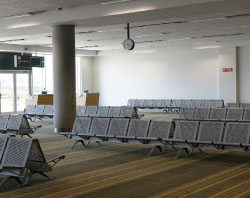
In 2005, the concession company Hermes Airports and the Cypriot government signed the 25-year concession agreement for the design, construction and financing of new terminal buildings at Pafos and Larnaka, and the operation of both airports.
LCC convenience
The new facility is considered particularly convenient for the operation of low-cost carriers, which currently have a very limited presence in Cyprus. “Pafos’ traffic is more than 85% based on the UK market. In the context of a global downturn and in consideration of the new Larnaka terminal commissioning next year, Pafos airport has to demonstrate efficiency and cost effectiveness to face hard competition in unfavourable times,” said Baric.
In order to reduce its exposure to the UK market, Pafos is working on developing interest in Cyprus and Pafos in particular from Russia, Scandinavia and Eastern Europe.
“The airports were a weak element in the travelling experience to Cyprus. We truly believe that our coordinated efforts with all stakeholders in the tourism industry will lead to a new era for tourism in Cyprus. The airports of Cyprus represent the first and last impression visitors have of the island whether they are travelling on business or leisure journeys and as such it is vital that these new terminals are of a world class level,” said Baric.
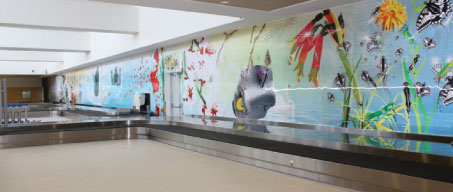
“The architectural and interior design of the terminal responds to the demands of a 21st century international airport yet responds to the local context, culture and history of the site adjacent to the water to the west of the island of Cyprus,” said Ian Douglas, Director, Pascall+Watson architects.
Following the Pafos opening, construction of the new Larnaka terminal is well underway. Many of the talented team that worked on Pafos have shifted their focus to the new project. Southern said: “Given the scale of the two projects, Pafos provided us with an opportunity to scope the resources required for the larger project in Larnaka. Further, we established relationships between the various contractors, suppliers and partners that will ensure a cohesive team in Larnaka.”
SSP introduces local flavours and international favourites at Pafos
SSP has opened a range of new cafes and restaurants at Pafos. It has introduced a different conceptual approach to that applied in the existing terminals at the airport.
The outlets are managed by SSP and operated by Cyprus Airports Food and Beverage Company, a joint venture between SSP, Louis and CTC-ARI. They include combined free-flow units, a food village featuring well-known international brands such as Sbarro, Upper Crust, as well as a fish and chip concept. The Mosaic café, with its Mediterranean themes, has been tailor made for the airport and draws on the heritage and style of Pafos and Cyprus; there is also a Caffè Ritazza.The ‘Beer Garden’ provides an outdoor space in the airside area and was incorporated into the offer on advice to the airport from SSP. “A beer garden outside in the departures area will help passengers to prolong their enjoyment of Cyprus’ great climate,” said George Antoniou, managing director of SSP’s Eastern Europe and Middle East division. “This is another first for us in Cyprus.”
In the landside area is a Costa Coffee to appeal to arriving and departing passengers, as well as airport visitors. Another concept to cater for the needs of ‘meeters and greeters’ is the Kafenion, introduced close to the car park and transport parking areas. The Premium Lounge, also managed by SSP, will provide VIP lounge services.
“This venture has been a great partnership between the shareholders of Cyprus Airports F&B Company,” said Antoniou. “In addition to mobilising this new business, our attention now turns to Larnaka Airport, which represents an exciting opportunity for us at SSP. We’ll again be calling upon our expertise in food and travel to create something highly innovative and perfectly suited for this important location.”







